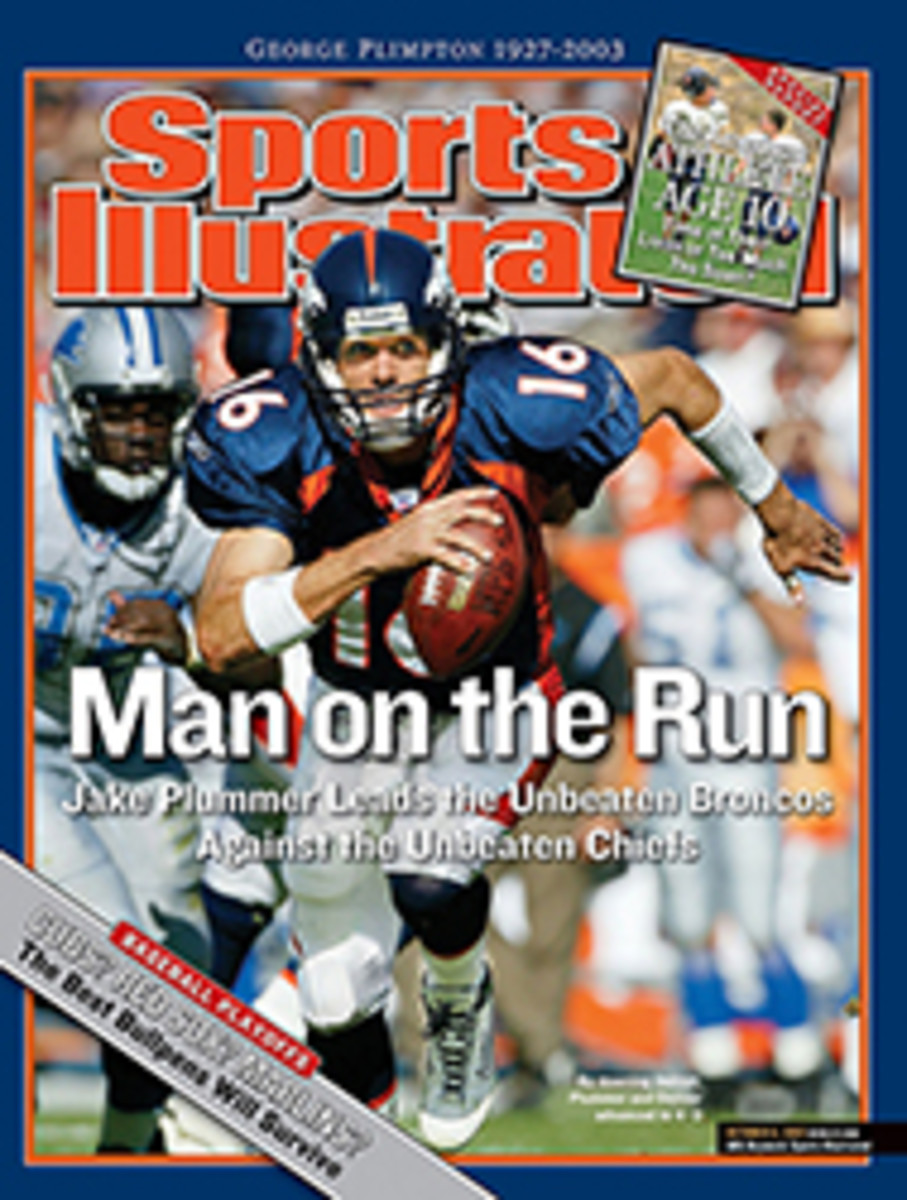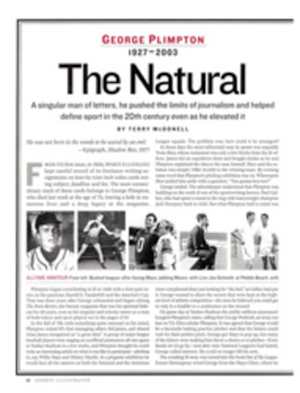
Field of Dreams For CHEESEHEAD NATION, season tickets at Lambeau are life's holy grail, though a lifetime often isn't long enough to successfully pursue it
James Madison wanted for his teenage son, Mark, only what most
Wisconsin fathers want for their boys: the chance to see their
beloved Green Bay Packers live at Lambeau Field. So when the
Madisons moved 156 miles north from Kenosha, Wis., to Green Bay,
James put their names on a season-ticket application in the late
1960s. Sure, the waiting list was notoriously long, but they had
a lifetime ahead of them, and with any luck, they'd get to
watch a game together in those seats someday.
"It makes me happy and a little sad to think about it," says
Mark, now 53 and a social worker living in Oshkosh. "My dad was
such a huge fan. He died 31 years ago. Looking back, I'm sure he
thought I'd have those tickets by now."
More than three decades later he almost does. Though 11,625 seats
were added to the stadium during the $295 million renovation
completed in late August--raising Lambeau's capacity to
72,515--Madison found out in mid-September that he'd climbed to
only No. 13 on the waiting list. No matter: Waiting year after
year for the right to sit on an aluminum bench and nearly freeze
to death during Green Bay's arctic Sundays is what you do if
you're a Packers fan. That's what makes them the heartiest breed
in American pro sports.
We give you the Cheeseheads, a devoutly worshipful bunch who
prefer their seats without backrests and their home-game
temperatures below zero. To them, football with a frigid
windchill factor and a beer before noon isn't just a
pastime--it's like going to church. Consider, for example, the
Packers' season-opening game against the Minnesota Vikings, on
Sept. 7. By Friday night the parking lot at Lambeau Field has the
feeling of a revival meeting, as it teems with RVs full of fans
who have driven hours from towns like Pembine and Kaukauna, Eau
Claire and River Falls.
By Saturday, getting a hotel room within a 50-mile radius of
Green Bay is impossible. At the stadium thousands of fans make
their way to the newly erected, 14-foot-tall bronze statues of
the franchise's twin titans, team cofounder and longtime coach
E.L. (Curly) Lambeau and the team's--and perhaps the
game's--greatest coach, Vince Lombardi. (It's a pairing the two
men probably would not have appreciated since they detested each
other; the prudish Lombardi disapproved of the rakish Lambeau's
extracurricular activities.) After the requisite pictures are
snapped, most fans head to the souvenir shop to buy curios.
(Refurbished during the renovation, the shop exceeded its
first-year sales projections in its first month.) By Sunday the
two car-choked interstates leading to Green Bay resemble the
twinkling, proselyte-filled highways in Field of Dreams.
Fasting is not part of keeping the faith. Grilled meats and
spirits of every variety can be found in abundance hours before
game time. For longtime tailgater "Super" Rob Sigler, a
45-year-old banker, this is "as close to heaven as most people
will ever get." Says David Burns, 37, the manager of a local
radio station who joined the congregation when he moved to Green
Bay from Minnesota 17 years ago, "Look at these people. They're
like a cult."
Indeed, as Burns's two-year-old daughter, Samantha, played under
the massive Lombardi statue, her antics were enjoyed by a couple
in their 50s wearing ... those hats. The Cheeseheads handle, of
course, derives from the triangular foam crowns worn in homage to
the best-known export of America's Dairyland. According to the
Packers' executive director of public relations (and unofficial
team historian), Lee Remmel, it's not clear when the first
unsightly wedge appeared, though it's believed the tradition
dates back to at least the mid-1970s. While some lament the
small-town-rube image evoked by the headgear--"The cheesehead,"
says Remmel with a weary smile, "is an abomination"--Cheesehead
Nation's fierce pride in its roots is unquestioned and
contagious. Such obsessive devotion, along with the team's long
record of success (including 12 league championships since its
1919 inception), have made the Pack nothing less than a state
treasure and support of the team a civic duty.
For thousands of fans, part of that support is financial. The
team has been a publicly owned nonprofit corporation--the only
American pro sports team so held--since 1923, when the first of
four stock sales was held to keep the fledgling club in business.
The second was held in 1935; the third, in 1950, essentially
saved football in Green Bay, keeping the near-bankrupt team
solvent long enough for the building of Lambeau Field (known as
City Stadium when it opened in '57) and for Lombardi to arrive in
'59. The most recent offering, in 1997, swelled the total number
of shareholders (who receive no dividend payments) to 111,507.
Bruce Barrette, a dentist in Peshtigo, displays the stock
certificate for his lone share on his office wall, "where no one
can miss it," he says. "Most team owners are arrogant or pompous,
but here, we own the team. It means everything to us."
Wisconsin governor Jim Doyle agrees. Doyle grew up in Madison and
vividly remembers the Sundays of his youth, hustling home from
church to watch the Pack (and the Hamm's beer commercials) on TV
with his father. "The Packers are more than just a state team,"
says Doyle. "They determine the state's mood. They throw this
state into a depression if they lose. Productivity is affected.
It's been like that forever." (Statewide anxiety levels, which
were running high after Green Bay got off to a 1-2 start, came
down a bit after the Packers beat the Chicago Bears 38-23 on
Monday night.)
Certainly part of the team's appeal is the notion of Green Bay
(pop. 102,726) as the Little Burg That Could, holding its own and
even outperforming teams from much larger cities. When the
Packers first began playing 84 years ago, their schedule included
teams from similarly small Wisconsin towns such as Menominee and
Sheboygan and Racine. By the early '30s, however, most area teams
had folded. The football-mad state had only the Packers, who by
then were playing a portion of their games in Milwaukee, further
expanding their fan base. Thus began the mythology, and statewide
worship, of the Green Bay Packers. "We've been the best thing
going for a long, long time," says team president Bob Harlan. "In
Wisconsin this is ingrained in you from birth. We're talking
generations here. It's a way Wisconsin families have marked the
passage of time."
Many fans recall a past in which family members and former
Packers regularly rubbed elbows. In the early '50s Barrette's
physician father, Antoine, attended games for free, sitting in a
section reserved for doctors who would assist injured players
during the game. In the '60s Mark Madison's mother, Betty, made
shirts for Packers guard Jerry Kramer on her home sewing machine.
Green Bay was that kind of town, and still is.
As for getting his tickets, Madison remains hopeful. "I'm just
happy to be so close," he says. "The funny thing is, there are
tons of people who'd love to be in my shoes right now." He's
right: According to Packers ticket director Mark Wagner, the
waiting list is a staggering 61,000 names long. But even that
number is worse than it sounds, since every person is entitled to
up to four seats, and once purchased, the seats can be bequeathed
to blood relatives, including first cousins. And so the list
grows ever longer. "We only ask that children actually be born
before they're placed on the list," Wagner says.
Brian Veto waited until his son, Logan, was eight months old
before adding his name in late August, making Logan the last
person on the waiting list as of the season opener. "I signed up
too," says the elder Veto, who is a 38-year-old road construction
worker from Yorkville, "but he's the one with a realistic shot.
Chances are, I'll be dead by the time he gets those tickets."
Then he laughs, happy and a little sad, having glimpsed his
mortality as only a Cheesehead can.
COLOR PHOTO: PHOTOGRAPHS BY JAMES V. BIEVER SUNDAY SERVICE A congregation of 72,515 faithful fans at every home game gives Lambeau Field the feeling of a religious revival.
COLOR PHOTO: PHOTOGRAPHS BY JAMES V. BIEVER HEAD CHEESE Though some hate the image it inspires, Packers headgear lives on.
COLOR PHOTO: MIKE ROEMER/AP ALL FIRED UP Lobster tails on the grill is just one of the signs that tailgating is serious business at Packers games.
For more about sports in Wisconsin and the other 49 states, go to
si.com/50.
"The Packers are more than just a state team," says Governor Jim
Doyle. "They determine the state's mood. Productivity is affected
when the lose."

